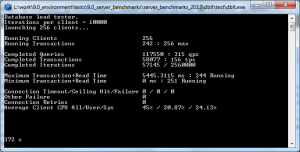I’ve recently been digging through a bunch of old test programs and scripts I’ve written over the years, and thought I’d upload some of them incase they can be of any use to anyone. I thought I’d start off with a console app I’d named DBLT.
DBLT is simply the abbreviation for “database load test” that jumped into my head when faced with the Visual Studio “New Project” dialogue. I wanted to perform some load tests in a way that more closely represented a specific application and measured the things I was interested in. I don’t class it as a polished testing platform, and I take the results of my tests with a pinch of salt; as I assume some of my techniques in running the tests and locking when maintaining the statistics will in some way have skewed them, but hopefully only slightly.
The test is written in C#, and uses the npgsql data provider to connect to PostgreSQL. As I mentioned initially, the main reason for this is I wanted to test different configurations in connecting to our databases in a similar way to how a specific application did. Mainly this was to test the performance of npgsqls local connection pool logic, and other associated parameters, but also to test other parameters on our pgBouncer pools, PostgreSQL and Linux hosts.
My other reason for writing my own test is that pgbench outputs results based around TPS, but I wanted a slightly different take on the statistics. I wanted to know things like how long my queries were taking on average, what the worst and best execution times were and the standard deviation of execution time to see that we were providing a good quality of service to all clients rather than just shunting the most TPS through the database. If you’re now thinking “the fool – he should have just run pgbench and run an analysis on his logs”, you’re quite right; but what that wouldn’t have given me an overall view of the behaviour of the system when we start including things like cascaded connection pools (local npgsql, and pgbouncer), networking and local client machine configuration. I could have analyzed some of this using tools like tsung, but had issues generating heavy load with tsung and its output didn’t give me exactly what I wanted.
I wrote dblt back in 2009, and I’ve found it useful on quite a few occasions but never thought to share it before. I’ve recently signed up to github so the source can be obtained from glynastill/dblt or my git repository at postgresql/dblt. I’ve also uploaded a compiled binary here
Hopefully someone finds it useful or highlights failings that can be fixed. Even if you don’t want to test against PostgreSQL it could quite easily be used to test sql server or other systems by changing the data provider.

